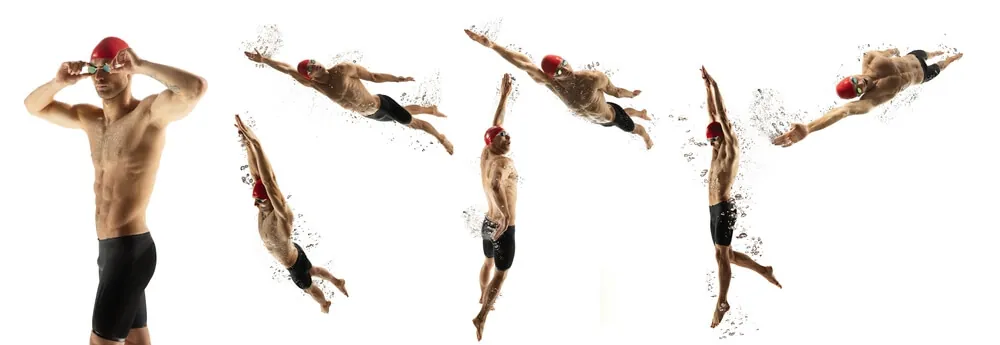
Whether you’re a novice looking to conquer the water for the first time or an experienced swimmer looking to refine your technique, learning (and mastering) the four fundamental swimming strokes is key to your success.
In this comprehensive guide, we’ll dive into the intricacies of the four primary swimming strokes – breaststroke, backstroke, butterfly, and freestyle – uncovering the mechanics, benefits, and tips to help you glide through the water with confidence.
- Breaststroke
- Butterfly
- Freestyle/front crawl
- Backstroke
Breaststroke
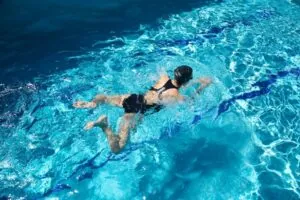
The breaststroke is a staple of recreational swimming, known for its distinctive combination of arm movements, leg kicks, and rhythm. Also known as the “frog kick”, it’s a classic swimming style loved by many for its full-body benefits, as it uses the legs and arms in a coordinated way.
You start by reaching your arms forward, then sweep them back while your legs kick out (like a frog, hence the name) to propel you gracefully through the water.
This stroke also has other perks, including giving your heart and muscles a good workout, especially in your legs, core, and arms. It also improves coordination and flexibility as you synchronise your arms and legs.
Its gentle pace is calming for swimmers, making it perfect for a relaxing swim session.
Butterfly
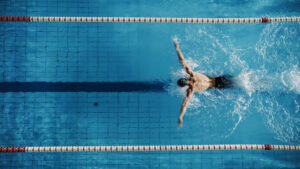
The butterfly stroke, often just known as “butterfly”, is a visually captivating swim stroke, whose symmetrical arm movements combine with a dolphin-like kick.
However, this swim stroke is not just about aesthetics, it also demands coordination, strength, and timing, something which offers an excellent workout for swimmers.
Many regard it the most difficult stroke to master due to its simultaneous, symmetrical arm movements and consistent kick to maintain momentum.
The entire body must move in a wave-like manner which demands strong core muscles and precise coordination from the swimmer. Learning the butterfly stroke can take time, but with patience and guidance, it’s entirely achievable.
Freestyle/front crawl
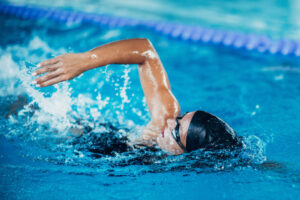
When you think of popular swimming strokes, the most popular one that comes to mind is the front crawl.
Also known as “freestyle” – as it’s the predominant style in competitive swimming – the front crawl requires the swimmer to kick their legs up and down while moving their arms in a windmill motion, rotating from one arm to the other.
The front crawl freestyle stroke engages multiple muscle groups, making it an excellent workout for both upper and lower body. From your core to your calves, every muscle is engaged.
Similarly, with the right technique, swimmers can achieve remarkable speeds, making it a favourite for races. It boasts a streamlined position and powerful kicks to give swimmers the advantage of covering significant distances in a shorter time.
The front crawl also promotes rhythmic breathing, enhancing lung capacity and endurance, which is great for long-distance swims.
However, the front crawl can be a difficult stroke for beginners to master due to the coordinating arm movement with breathing and kicking.
Backstroke
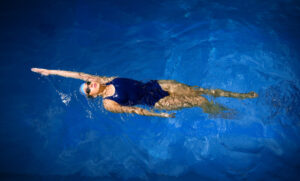
The final of the four popular swimming strokes is the backstroke. As the name suggests, swimmers lie on their backs throughout the swim. The body should be straight and close to the water’s surface, reducing resistance and allowing for smooth motion.
The stroke cycle in the back crawl involves a rhythmic movement of the swimmer’s arms, legs, and torso. The arms pull underwater in a semi-circular motion independently, propelling the swimmer forward in a continuous, alternate movement that ensures momentum and speed.
The elementary backstroke is a simple, relaxed version of this stroke, where the swimmer uses a synchronised movement of both arms while the legs perform a kind of ‘whip kick’ motion.
Many swimmers regard the back crawl as a difficult stroke because it forces them to propel forward without seeing exactly where they’re going.
However, with time and practice, it can soon become second nature. In fact, when performed correctly, the back crawl can be a fast stroke, the average speed of which can make it a competitive choice for races.
Learning the four swimming strokes
Every competitive stroke in swimming carries its own rhythm and style. The beauty of the basic swimming strokes lies not just in their efficacy and harmony they bring between the swimmer and water.
For the beginner swimmer, it can feel overwhelming trying to master these various strokes, but the secret lies in a simple technique – starting with the basics and gradually building on them. No world champion was born with impeccable swimming technique, it’s honed over time and dedicated practice.
So, if you’re looking for dedicated, professional swimming lessons in Edinburgh or Glasgow, look no further than MJ Swim Academy.
Our professional tutors, led by Scottish Olympic silver medallist, Michael Jamieson, offer comprehensive small classes for babies, children, as well as swimming lessons for adults in venues across Scotland.
Get in touch to book your swimming lessons today.